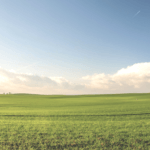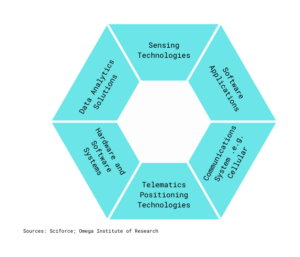- Industries
Industries
- Functions
Functions
- Insights
Insights
- Careers
Careers
- About Us
- Sustainability
- By Omega Team

Smart farming refers to managing farms using technologies like AI, IoT, robotics and drones to increase quantity and quality of product while optimizing the human labor required by production.
The technologies available in today’s smart farms are:
- Sensors: soil, water, light, humidity, temperature management
- Software: specialized software solutions that target specific farm types or Applications agnostic IoT platforms
- Connectivity: cellular, LoRa, etc.
- Location: GPS, Satellite, etc.
- Robotics: Autonomous tractors, processing facilities, etc.
- Data analytics: standalone analytics solutions, data pipelines for downstream solutions, etc.
Figure 1: Smart Farm Breakdown

Why is Smart Farm needed?
According to the United Nations’ prediction data on population and hunger, the world’s population will increase by 2 billion people by 2050, requiring a 60% increase in food productivity to feed them. In the U.S. alone, growing, processing and distributing food is a $1.7 trillion business, according to the U.S. Department of Agriculture’s Economic Research Service. AI and ML are already showing the potential to help close the gap in anticipated food needs for an additional 2 billion people worldwide by 2050.
Gaining insight into how weather, seasonal sunlight, migratory patterns of animals, birds, insects, use of specialized fertilizers, insecticides by crop, planting cycles and irrigation cycles all affect yield is a perfect problem for machine learning. How financially successful a crop cycle is greatly dependent on excellent data. Farmers, co-ops and agricultural development companies are doubling down on data centric approaches and expanding the scope and using AI and machine learning to improve agricultural yields and quality.
10 ways AI can potentially improve agriculture
1. Using AI and machine learning-based surveillance systems to monitor every crop field’s real-time video feeds identifies animal or human breaches, sending an alert immediately.
2. AI and machine learning improve crop yield prediction through real-time sensor data and visual analytics data from drones.
3. Yield mapping is an agricultural technique that relies on supervised machine learning algorithms to find patterns in large-scale data sets and understand the orthogonality of them in real-time.
4. Pioneering drone data combined with in-ground sensors to improve pest management.
5. Making AI and machine learning-based smart tractors, agribots and robotics a viable option for many remote agricultural operations that struggle to find workers.
6. Improving the track-and-traceability of agricultural supply chains by removing roadblocks to getting fresher, safer crops to market is a must-have today.
7. Optimizing the right mix of biodegradable pesticides and limiting their application to only the field areas that need treatment to reduce costs.
8. Price forecasting for crops based on yield rates that help predict total volumes produced are invaluable in defining pricing strategies for a given crop.
9. Finding irrigation leaks, optimizing irrigation systems and measuring how effective frequent crop irrigation improves yield rates.
10. Monitoring livestock’s health, including vital signs, daily activity levels and food intake, ensures their health.
The IoT-Based Smart Farming Cycle
Internet of Things (IoT) describes the network of physical objects (things) that are embedded with sensor, software, and other technologies. IoT devices are sensor-equipped tools that are connected to the internet. Combined with AI, such smart devices can be implemented to increase yields and productivity, while reducing crop failures by monitoring, analyzing and forecasting data.
The application of IoT in agriculture will completely change our traditional view of agriculture. To optimize the farming process, IoT devices installed on a farm should collect and process data in a repetitive cycle that enables farmers to react quickly to emerging issues and changes in ambient conditions. Smart farming follows a cycle like this one:
1. Observation : Sensors record observational data from the crops, livestock, soil, or atmosphere.
2. Diagnostics: The sensor values are fed to a cloud-hosted IoT platform with predefined decision rules and models—also called “business logic”—that ascertain the condition of the examined object and identify any deficiencies or needs.
3. Decisions : After issues are revealed, the user, and/or machine learning-driven components of the IoT platform determine whether location-specific treatment is necessary and if so, which.
4. Action : After end-user evaluation and action, the cycle repeats from the beginning
Precise farming and livestock farming
IoT makes farming more controlled and accurate. The biggest difference from the classical approach is that precision farming allows decisions to be made per square meter or even per plant/animal rather than for a field. By precisely measuring variations within a field, farmers can boost the effectiveness of pesticides and fertilizers, or use them selectively.
IoT-driven smart greenhouses can intelligently monitor as well as control the climate, eliminating the need for manual intervention. Various sensors are deployed to measure the environmental parameters according to the specific requirements of the crop.
It also enable farmers better to monitor the needs of individual animals and to adjust their nutrition accordingly, thereby preventing disease and enhancing herd health. Wireless IoT applications to monitor the location, well-being, and health of their cattle. With this information, they can identify sick animals, so that they can be separated from the herd to prevent the spread of disease.
Agricultural Robots and Drones
According to the International Labor Organization (ILO), agricultural laborers as a percentage of the workforce declined from 81.0% to 48.2% in developing countries and 35.0% to 4.2% in developed ones by 2014. The shortage of people working on farms is growing globally. In the Asia Pacific, especially in Japan alone, the number of people working in farms dropped from 2.2 million in 2004 to 1.7 million in 2014. Such a huge decline in the workforce of about 12.8% is also observed in the European agriculture sector. Such decline for the workforce is observed due to lack of young people becoming farmers, finding it unattractive and skill shortages are encouraging farming automation technologies.
The main goal of agricultural robots is the automation of field activities, meaning saving farmers time on dull, regular tasks so that they could focus on more important work. There is a variety of such robots for different purposes, including seeding, harvesting, weed control, tilling and chemicals application. The use of software and hardware complexes for replacing drivers of agricultural vehicles can ensure the reduction of waste and higher yields due to more precise land cultivation.
Milking robots are one of the most successful and important innovations in the dairy farming system. According to the International Federation of Robotics, Milking Robots occupy 85% share of field robots. The average sales of Milking Robots increased by about 9.4% between 2016 and 2017. Nearly 20,000 dairy farms have installed robots in Western Europe, Canada, US, China, and Japan. The factors like increased milking frequency and high labor flexibility are driving milking robots market.
Figure 2: Agricultural Robots

Agricultural drone technology has been improving in the last few years, and the benefits of drones in agriculture are becoming more apparent to farmers. Drone applications in agriculture range from mapping and surveying to cropdusting and spraying. Increased automation stemming from a lack of skilled resources and a labor crisis will also bolster agricultural drone demand. There are numerous types of agricultural drones on the market already.
Agricultural drone is widely used to map or survey corps. Many newer agricultural drone models come equipped with flight planning software that allows the user to draw around the area they needs to cover. Then, the software makes an automated flight path and, in some cases, even prepares the camera shots. Drones are also used for cropdusting and spraying. They are usually capable of spraying crops with far more precision than a traditional tractor. This helps reduce costs and potential pesticide exposure to workers.
Future Outlook
Smart farm will have a huge potential in the future. In order to cope with the increasing demand for the quantity and quality of food production and the scarcity of skilled labor, it is an inevitable trend to make agriculture thoroughly intelligent. Imagine a future in which AI-controlled sensors constantly and precisely monitor the status of food and livestock. This data will ensure the most efficient use of resources, greatly reducing costs while increasing yields. Farmers won’t have to go to the fields themselves, as automated robots and drones will do everything from planting, spraying to picking. In animal farms automation will largely replace human labor as well. At present, many AI agriculture projects are in the early stages of development. But AI-powered tools and devices have already proved to improve farming and seem to continue to do so in the future. The demand for such technologies will remain high in the future.
Subscribe
Select topics and stay current with our latest insights
- Functions